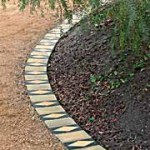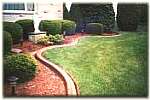It is the perfect spring day and you are sitting in the warm sun basking in the beauty of your newly planted flower beds and new paver patio while drinking a glass of white wine.  The smell of flowers blooming is in the air and there is a slight breeze, you think to yourself that this is literally the perfect oasis – but all good things must come to an end so you put down your book and wine and go back into the house to do the laundry. Fast forward one week: there have been rain storms and major winds and you can’t wait for the sun to shine so that you can enjoy your garden once again. Much to your dismay, you enter your once beautiful landscaped backyard to see the soil from your planter splattered across your patio!! Now your poor plants are swimming in water due to the lack of soil that once surrounded it, and you think to yourself, this could have all been avoided with a little landscape edging…
The smell of flowers blooming is in the air and there is a slight breeze, you think to yourself that this is literally the perfect oasis – but all good things must come to an end so you put down your book and wine and go back into the house to do the laundry. Fast forward one week: there have been rain storms and major winds and you can’t wait for the sun to shine so that you can enjoy your garden once again. Much to your dismay, you enter your once beautiful landscaped backyard to see the soil from your planter splattered across your patio!! Now your poor plants are swimming in water due to the lack of soil that once surrounded it, and you think to yourself, this could have all been avoided with a little landscape edging…
Many people when they think of landscape edging think of simple bricks piled on top of each other to create an outline, but landscape edging has come so much further than that! Landscape curbing is crucial if you intend on preserving your planters, garden  bedding and walkways. If you fail to use a form of landscape curbing, you will find yourself in a very similar circumstance as denoted above. Landscape edging not only protects your garden beds and planters from rain but also from snow and pedestrian traffic. Landscape curbing also adds an aesthetic finish that is difficult to argue with, essentially it is the “frame for the landscape”.
bedding and walkways. If you fail to use a form of landscape curbing, you will find yourself in a very similar circumstance as denoted above. Landscape edging not only protects your garden beds and planters from rain but also from snow and pedestrian traffic. Landscape curbing also adds an aesthetic finish that is difficult to argue with, essentially it is the “frame for the landscape”.
Okay, so now we are assuming that you are sold on the concept of landscape edging (right?), and are probably wondering what type of materials can be used for landscape edging. Primarily there are three types of materials that are most commonly used for landscape edging: brick, stones, and concrete pavers. All of these materials are not  only aesthetically beautiful, but are durable and practical (how often are beautiful and practical in the same sentence?) The question that now most likely comes to mind is, how do I choose a material? Well, one recommendation would be to use the same type of material that had previously been used for the patio to allow for a sense of congruency. Overall, it is probably most beneficial to ask yourself these questions:
only aesthetically beautiful, but are durable and practical (how often are beautiful and practical in the same sentence?) The question that now most likely comes to mind is, how do I choose a material? Well, one recommendation would be to use the same type of material that had previously been used for the patio to allow for a sense of congruency. Overall, it is probably most beneficial to ask yourself these questions:
- What am I trying to frame? Do I want to bring attention to it or have it blend in?
- Do I want it to be more decorative in nature or more subtle?
- Do I want it to have a different texture than the solid surface that it bumps up against?
- What is my purpose of having landscape curbing? Aesthetics, functionality or both?
These questions may give you a little bit of direction when it comes to selecting a type of material for landscape curbing. While there are certain “Rules of Thumb” if you will, remember, it is your space and as long and you are happy with the result, you can’t go wrong!
